P-type semiconductors contain an abundance of holes as charge carriers due to the addition of trivalent impurities, while N-type semiconductors have extra electrons from pentavalent impurities that enhance conductivity. Explore the rest of the article to discover how understanding these differences can optimize your electronic device performance.
Comparison Table
| Feature | P-type Semiconductor | N-type Semiconductor |
|---|---|---|
| Doping Element | Acceptors (e.g., Boron) | Donors (e.g., Phosphorus) |
| Majority Charge Carriers | Holes (positive charge) | Electrons (negative charge) |
| Minority Charge Carriers | Electrons | Holes |
| Conductivity Type | Positive (hole conduction) | Negative (electron conduction) |
| Electrical Behavior | Holes act as current carriers | Electrons act as current carriers |
| Material Example | Silicon doped with Boron | Silicon doped with Phosphorus |
| Application | Used in p-n junctions, transistors, solar cells | Used in p-n junctions, transistors, solar cells |
Introduction to P-type and N-type Semiconductors
P-type semiconductors are created by doping silicon with elements like boron that introduce positive holes as majority charge carriers, enhancing conductivity. N-type semiconductors result from doping with elements such as phosphorus, providing extra electrons as majority charge carriers. Your understanding of these fundamental differences is crucial for designing and optimizing electronic devices like diodes and transistors.
Basic Principles of Semiconductor Doping
P-type semiconductors are created by doping a pure semiconductor, typically silicon, with elements from group III of the periodic table, such as boron, which introduces "holes" or positive charge carriers. N-type semiconductors result from doping with group V elements like phosphorus, adding extra electrons that serve as negative charge carriers. Understanding these basic principles of semiconductor doping helps optimize your electronic devices by controlling conductivity and charge flow.
Structure of P-type Semiconductors
P-type semiconductors are formed by doping intrinsic silicon with trivalent elements such as boron, which create "holes" or positive charge carriers within the crystal lattice. The absence of an electron in the valence band facilitates electrical conductivity through hole movement, distinguishing P-type from N-type where electrons dominate. The hexagonal crystal structure of silicon remains intact, but the introduced acceptor atoms produce localized energy levels just above the valence band, enabling efficient hole conduction.
Structure of N-type Semiconductors
N-type semiconductors are structured by doping pure silicon with elements like phosphorus or arsenic that have five valence electrons, introducing extra electrons as charge carriers. This doping creates an abundance of negatively charged electrons, which enhances electrical conductivity by increasing free electron concentration in the material. Your understanding of the structure highlights that the majority carriers are electrons, making N-type materials essential in electronic devices such as diodes and transistors.
Key Differences Between P-type and N-type
P-type semiconductors are created by doping silicon with elements such as boron, which introduce holes as majority charge carriers, whereas N-type semiconductors are doped with elements like phosphorus, providing electrons as majority carriers. P-type materials have positive charge carriers (holes) that facilitate current flow, while N-type materials rely on negative charge carriers (electrons) for conduction. The essential difference lies in the type of dopant impurity and the resulting majority charge carrier that defines their electrical properties and behavior in electronic devices.
Electrical Conductivity Comparison
P-type semiconductors contain holes as majority charge carriers, resulting in electrical conductivity driven by positive charge movement, whereas N-type semiconductors have electrons as majority carriers, providing higher electrical conductivity due to the greater mobility of electrons compared to holes. The intrinsic difference in carrier mobility means N-type materials typically exhibit superior electrical conductivity, enhancing performance in high-speed electronic applications. Understanding this comparison can help you select the appropriate semiconductor type for optimizing your device's electrical efficiency.
Role in Electronic Devices
P-type semiconductors contain an abundance of holes that act as positive charge carriers, facilitating current flow by accepting electrons. N-type semiconductors have excess electrons that serve as negative charge carriers, enabling efficient electron movement through the material. The interaction between P-type and N-type regions in electronic devices like diodes and transistors is fundamental for controlling current direction and amplification functions.
Applications of P-type Semiconductors
P-type semiconductors are widely used in applications such as diodes, transistors, and photovoltaic cells due to their ability to create positive charge carriers (holes). These materials are critical in forming p-n junctions, which serve as the foundation for electronic devices including LEDs and solar panels. Your electronic circuits often rely on P-type semiconductors to control current flow and enable efficient device operation.
Applications of N-type Semiconductors
N-type semiconductors, characterized by an abundance of electrons as majority carriers, are widely used in electronic devices such as diodes, transistors, and integrated circuits. Their high electron mobility enables efficient current flow in applications like logic gates, power amplifiers, and photovoltaic cells. The essential role of N-type materials in creating p-n junctions underpins the functionality of solar panels and LED technology.
Summary and Future Trends in Semiconductor Technology
P-type and N-type semiconductors form the fundamental building blocks of modern electronic devices by enabling controlled conductivity through positive hole and electron charge carriers, respectively. Future trends in semiconductor technology emphasize the integration of advanced materials like silicon carbide (SiC) and gallium nitride (GaN) to enhance efficiency, speed, and power handling in devices such as transistors and diodes. You can expect ongoing innovations to push the boundaries of miniaturization, energy efficiency, and thermal management, driving the next generation of high-performance electronics.
P-type vs N-type Infographic

 solderic.com
solderic.com